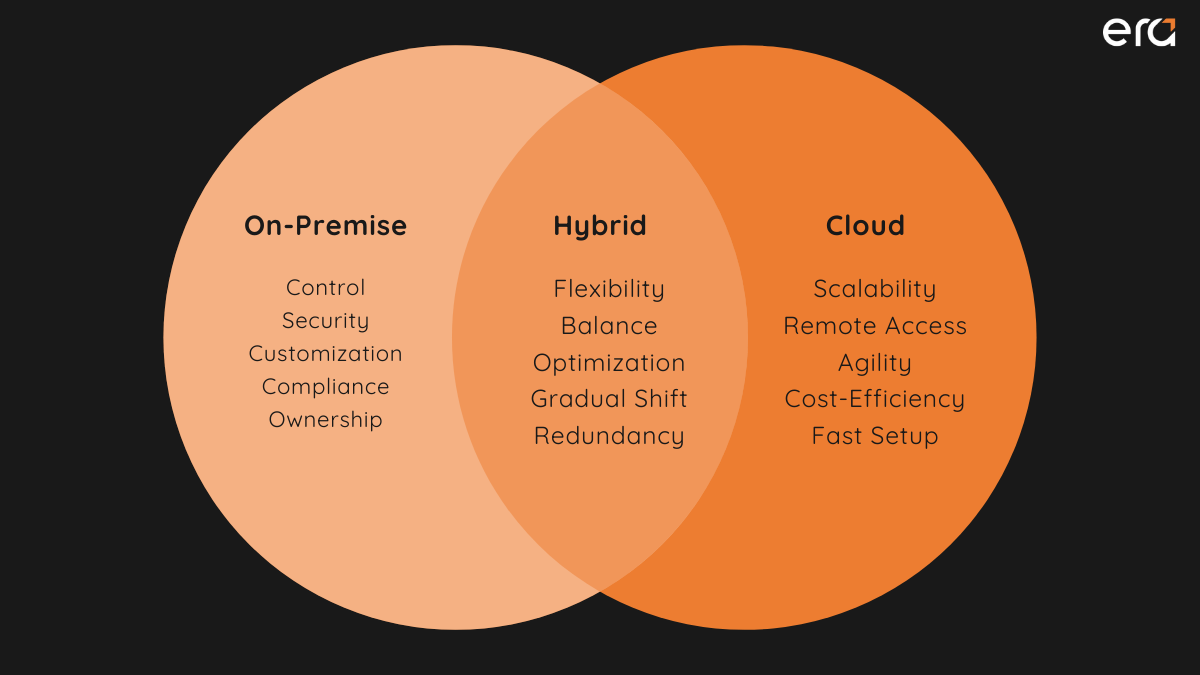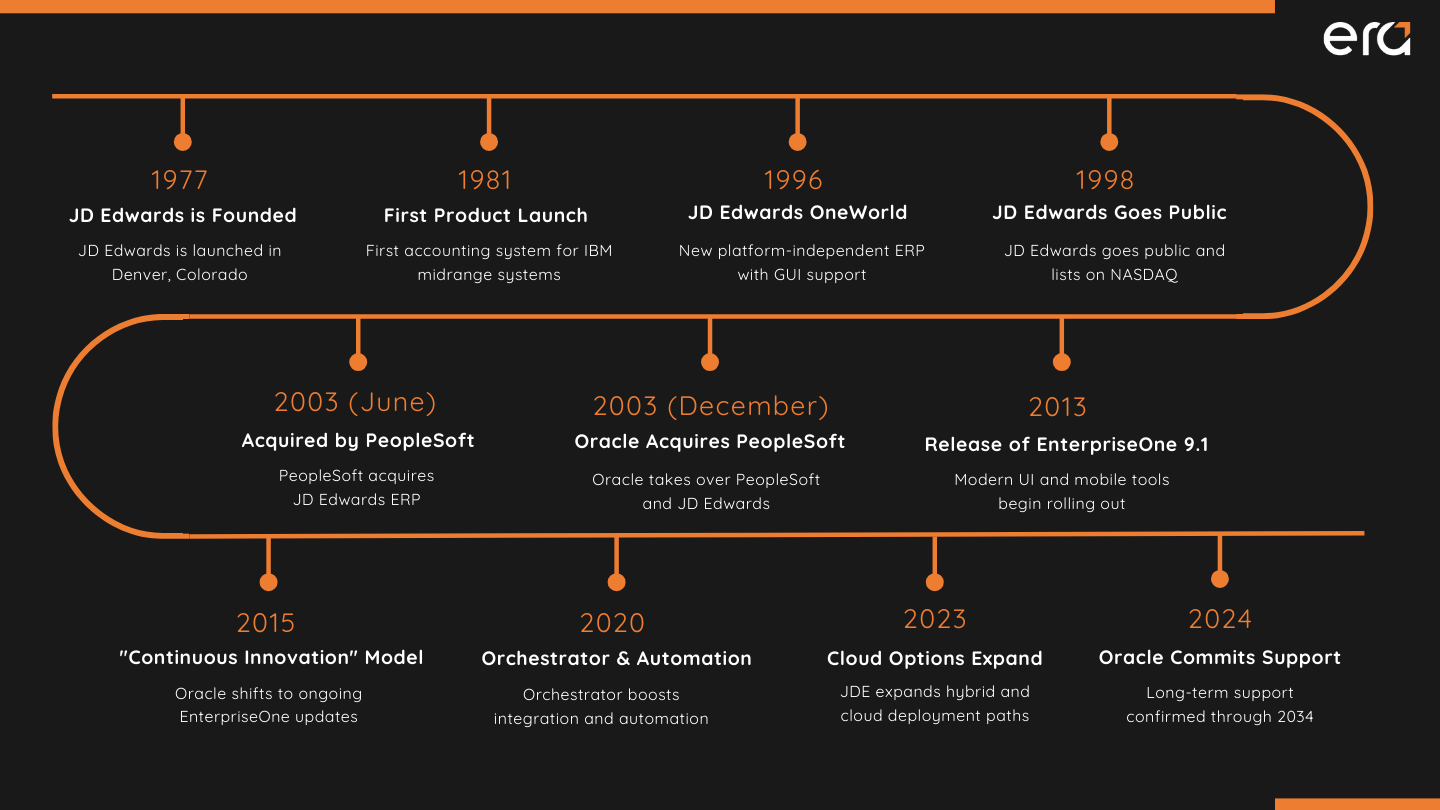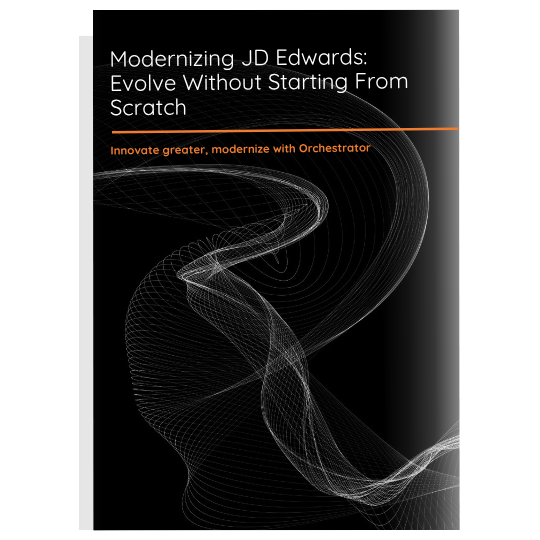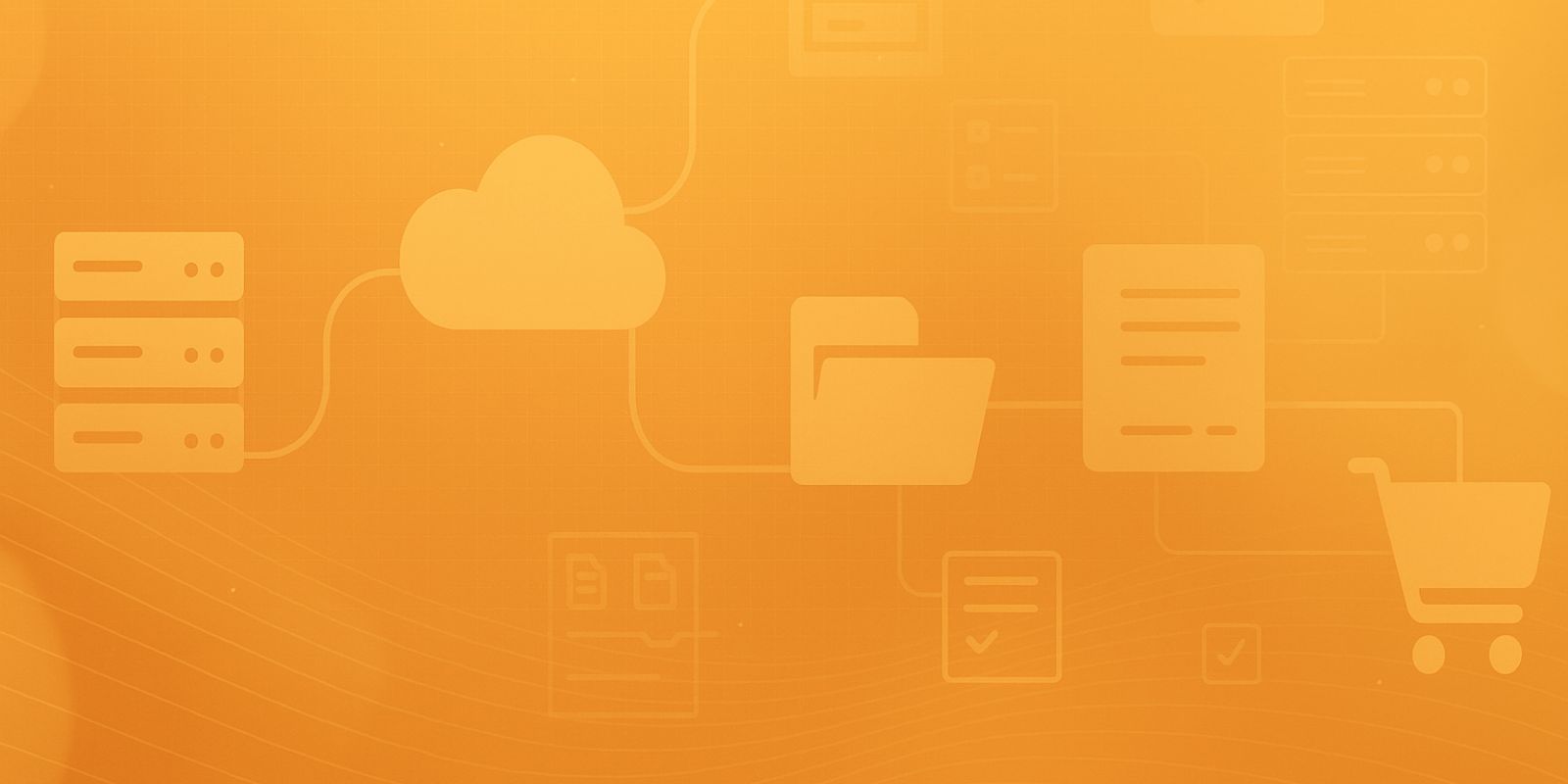What is JD Edwards?

Oussama Nait-Zlay
Content Marketing Manager
August 4, 2025
Ever wondered how large companies manage to keep their operations humming along tracking inventory, processing payroll, managing suppliers, without everything falling apart? The answer often lies in the systems working quietly behind the scenes. And one name that comes up again and again in that conversation is JD Edwards, a powerful ERP system that’s been helping businesses run smarter for decades. So, what is JD Edwards?
JD Edwards (or just JDE for short) is what you’d call a full-scale enterprise resource planning (ERP) system. It’s designed to help businesses manage and connect every part of their operations, from finance and procurement to human resources, manufacturing, and even customer service. Think of it as the central nervous system of a business: if one part needs something, the rest of the body knows.
Here’s a bit of backstory: JD Edwards was founded in 1977 by Jack Thompson, Dan Gregory, and Ed McVaney (yep, that’s where the name comes from). What started as a tool for finance and distribution has grown into a globally trusted ERP solution used by thousands of companies. And while it eventually became part of Oracle’s portfolio, it still operates with its own unique approach and user community.
So, what makes JD Edwards so reliable, even decades later? One word: flexibility.
Unlike rigid systems that expect you to change your workflows to match the software, JD Edwards adapts to you. It’s more like a tailored solution than an off-the-shelf product. Businesses can configure it to reflect the way they actually operate, whether that’s a complex manufacturing workflow or a multi-warehouse distribution setup.
There are two main versions:
-
JD Edwards World, the original version, still runs on IBM iSeries servers and has a loyal base of long-time users.
-
JD Edwards EnterpriseOne, Oracle's modern, web-enabled version, supports a wide range of databases, operating systems, and devices, making it a lot more adaptable to today’s IT environments.
And here’s the thing, JDE isn’t just for multinationals with sprawling IT departments. It’s used by mid-sized firms too, especially those in industries like manufacturing, distribution, construction and energy. It scales with you, so you're not stuck outgrowing your ERP every few years.
What problems does it solve? Quite a few. Disconnected systems, messy manual processes, departments that can’t talk to each other, or that frustrating feeling of not knowing what’s happening across the business, The JDE ERP system helps pull everything into one unified view. It’s all about clarity, consistency, and better decision-making.
Sure, implementing JD Edwards takes time, planning, and the right partner. But once it’s up and running, the payoff is real: smoother operations, stronger control, and a whole lot fewer headaches.
Next, let’s step back in time and see how JD Edwards evolved from a niche financial tool to one of the most trusted ERP platforms on the market today.
Before JD Edwards became the ERP solution that quietly powers global operations, it started with a pretty simple goal, help businesses manage their finances better. Back in 1977, Jack Thompson, Dan Gregory, and Ed McVaney set out to build something that didn’t really exist at the time: a flexible, integrated software system that could handle core business functions across departments.
At first, it was all about financial accounting and distribution. But as businesses started asking for more, like manufacturing tools, inventory tracking, HR capabilities, JD Edwards grew up right alongside them. It evolved from a niche back-office tool into a full-blown ERP platform used by organizations around the world.
By the late 90s, JD Edwards had launched its flagship solution, JD Edwards OneWorld, which later evolved into what we now know as EnterpriseOne. This version brought a more modern, modular structure and the ability to run on multiple databases and operating systems. It was a big shift, making the software more accessible for a variety of companies, not just those with IBM infrastructure.
Then came the big turning point: the acquisitions. First, JD Edwards was acquired by PeopleSoft in 2003, and shortly after, Oracle acquired PeopleSoft. Some might have worried that JDE would disappear into the Oracle ecosystem, but that didn’t happen. Instead, Oracle doubled down on development, investing in updates, modern features, and long-term support.
Today, JD Edwards still holds a distinct place in Oracle’s lineup. It’s maintained a strong user base, especially in some specific industries like manufacturing or distribution, where complexity is the norm and flexibility is essential.
So, while some ERP systems fade out with time, JD Edwards has kept pace. It didn’t just survive the changing tech landscape, it adapted to it.
Alright, so now that we know where JD Edwards came from, let’s look at what it really does. Because this isn’t just software for the finance team or something you install and forget. JD Edwards is built to be the backbone of daily operations, and its true value shows up in how it connects all the moving parts of a business.
At its core, JD Edwards is a modular ERP system, and its features are designed to cover every major business function, organized into modules that businesses can pick and choose based on what they actually need. No bloat, no unnecessary extras, just the tools that fit your operations.
Here’s a quick walkthrough of the major modules:
- Financial Management
From general ledger and accounts payable to fixed assets and expense management, this module gives businesses full control over their financial data. You can track budgets, manage multiple currencies, and generate real-time financial reports with the precision finance teams live for.
- Manufacturing Management
As a robust ERP for manufacturing, JD Edwards offers tools for shop floor control, work orders, quality management, and more. It’s designed to support both discrete and process manufacturing, giving full visibility into production timelines and materials.
- Supply Chain & Inventory Management
This is where things get interesting. With JDE, you can manage suppliers, track inventory levels, control warehouse operations, and plan procurement, all from a centralized system. If your business has complex supply chain needs, this module is a game-changer.
- Human Capital Management (HCM)
Yes, JD Edwards also helps with HR tasks. Think payroll, benefits administration, recruitment, and training management. It’s built to help HR teams stay organized while giving employees and managers self-service access to what they need.
- Procurement & Order Management
From purchase orders to sales orders, this module ensures that transactions flow smoothly across the organization. It connects your procurement processes to inventory, finance, and sales, so everything is tracked and accounted for.
- Project Management
For companies that run large-scale projects, whether in construction, engineering, or services, this module offers tools for job costing, resource allocation, scheduling, and billing. It’s ideal for keeping projects on time and within budget.
- Reporting & Business Intelligence
Let’s be honest, data is only helpful if you can make sense of it. JDE comes with built-in reporting and analytics tools that let businesses see trends, spot issues, and make better decisions. From dashboards to drill-down reports, the visibility is there.
The best part? These modules aren’t siloed. They talk to each other, share data in real time, and adapt as your business grows. You don’t have to add everything at once either. Start small, then expand when you’re ready.
Cloud, On-Premise, or Somewhere In Between?
If there’s one thing businesses appreciate when choosing an ERP system, it’s having options. Not every organization is ready to fully migrate to the cloud, and not every team wants to stick with on-premise forever. JD Edwards gets that, which is why it offers a flexible approach to deployment
You can run JD Edwards:
-
On-premise, if you want full control over infrastructure and data. This is still a popular choice for industries with strict compliance or security requirements.
-
In the cloud, using Oracle’s cloud infrastructure or a third-party provider. This setup gives you scalability, remote access, and often lower upfront IT costs.
-
Hybrid, a mix of both. Some businesses choose to keep certain components on-site, while shifting others to the cloud over time. It’s a smoother path for gradual modernization.

No matter which setup you go with, JD Edwards gives you the ability to customize your environment. You can run it on various databases and operating systems, integrate it with other Oracle tools or external apps, and scale resources as your needs evolve.
Now here’s the part that stands out, Oracle continues to release updates that support both cloud and on-premise users. That means you’re not being pushed into a particular direction before you’re ready. Instead, you’re in the driver’s seat, choosing the timeline and the setup that fits your business.
So whether you’re fully cloud-native or prefer to keep your ERP close to home, JD Edwards lets you build your tech strategy on your terms.
The real test of any ERP system isn’t in how long its feature list is, it’s in whether it actually helps a business run better. And that’s where JD Edwards has earned its reputation. Companies that implement it well don’t just keep the lights on, they unlock serious efficiency, reduce headaches, and get real visibility into what’s working and what’s not.
- Built for Complexity, Trusted by Industry Leaders
JD Edwards finds its sweet spot in industries where complexity isn’t optional. Think manufacturing, distribution and other sectors where one small delay in inventory or misstep in production planning can snowball into real business risk.
For manufacturers, it offers full visibility into production schedules, material requirements, and quality checks. Construction firms can track job costs in real time, manage subcontractors, and forecast project timelines, all without relying on disconnected spreadsheets. Distributors benefit from warehouse management, order fulfillment, and procurement tools that speak to each other without needing extra middleware or manual input.
But it’s not just about who uses it, it’s about how they use it.
- Integration That Breaks Down Silos
Before systems like JD Edwards, it wasn’t unusual for businesses to run five or six disconnected tools, one for payroll, one for inventory, another for purchasing. Data had to be passed manually, reports had to be reconciled by hand, and mistakes were common.
JD Edwards changes all that. When everything runs in the same environment, the information flows naturally. A sales order updates inventory, triggers a production schedule, and sends financial data to accounting, without any double entry or time wasted.
- Visibility That Drives Better Decisions
With JD Edwards, business leaders can see what’s happening across their operations in real time. You’re not waiting for someone to email a report or dig through spreadsheets. You can view KPIs, drill into data, and spot issues early, before they become costly.
- Tailored to Fit, No Coding Required
Not every business works the same way, and JD Edwards gets that. Its configuration with no coding approach lets companies tailor workflows, screens, and reports to match how they actually operate, without writing a single line of custom code. That means smoother upgrades, fewer maintenance headaches, and faster time to value.
And when it comes to industry-specific functionality, JD Edwards brings built-in tools to the table. Whether it’s cost tracking for manufacturers, inventory traceability in distribution, or resource planning in service-based operations, companies aren’t stuck customizing generic tools, they get features designed for their world, right out of the box.
- Ready for Growth, Not Just Today
One of the biggest reasons businesses stick with JD Edwards is scalability. You can start small (just financials, maybe HR) and add modules as you grow. And it’s all part of the same system. That’s a huge relief compared to bolting together six different platforms that don’t really talk to each other.
- On the Go? It Goes With You
Field service teams, sales reps, and execs on the move can access JD Edwards from smartphones and tablets. Whether it’s approving purchase orders, checking inventory, or updating a work order on-site, everything syncs in real time. It’s an ERP that keeps pace with the way people work now.
- Helping You Sleep at Night (Yes, Really)
Last but not least, JD Edwards helps businesses stay compliant. Built-in audit trails, approval workflows, and role-based access controls mean you’re not scrambling to meet regulatory requirements. Whether it’s Sarbanes-Oxley or internal risk policies, the system helps keep everything in check.
Now, it’s worth mentioning, these benefits don’t come out of the box without effort. Proper implementation, solid training, and some process rethinking are all part of the journey. But the businesses that commit to it? They walk away with stronger operations, sharper decision-making, and a setup that can support them for years.
With all the noise around newer SaaS platforms and cloud-first systems, it’s fair to ask, does JD Edwards still have a place in the modern ERP conversation? Short answer: absolutely. And not just as a legacy system quietly hanging on, but as a solution that's still evolving and proving its worth, especially for companies that need depth, control, and real-world flexibility.
- Still Evolving, Not Fading
Oracle hasn’t left JD Edwards in the past. In fact, regular updates continue to roll out for EnterpriseOne, including new features, user interface enhancements, and automation tools. The Continuous Innovation model introduced by Oracle ensures that JDE customers receive new functionality without needing to reimplement or go through disruptive upgrades.
And let’s not forget the long-term commitment, Oracle has extended for example the Premier Support for JD Edwards EnterpriseOne 9.2 through at least 2036. That’s a clear signal this isn’t going anywhere anytime soon.
- The Power of Choice
One of JD Edwards’ biggest strengths is the control it gives businesses over how and where they operate. Some ERP solutions push you toward a single way of working, often tied closely to one vendor's cloud ecosystem. JD Edwards is different.
You can run it on-premise, in the cloud, or in a hybrid model that balances performance, cost, and compliance. That flexibility is gold for businesses that want to modernize at their own pace, without being forced to fit someone else’s roadmap.
- Real-World Ready
Let’s face it, not every company wants to rip and replace systems every few years. For businesses that need deep functionality across finance, manufacturing, supply chain, and project management, JD Edwards still delivers.
Plus, with tools like Orchestrator, companies can now automate processes, connect external systems, and extend JD Edwards without heavy custom development. That’s a big deal for modernization without disruption.
- A Community That’s Still Going Strong
JD Edwards also has one of the most loyal user communities in the ERP world. From customer forums and webinars to third-party add-ons and integration partners, the ecosystem around JDE is still active and innovative. It’s not just software, it’s a network of people and expertise you can count on.
The ultimate guide to modernizing JD Edwards
Want to give your JD Edwards a refresh without starting from scratch? In this guide, you’ll learn how to:
- ✔ Use Orchestrator to integrate modern technologies
- ✔ Add new features (AI, e-commerce, custom apps)
- ✔ Plan a progressive and secure modernization
- ✔ And more!
JD Edwards might not always make the flashiest headlines, but it’s been quietly helping businesses stay organized, make better decisions, and grow year after year. It’s the kind of ERP system that just works, with the flexibility and power to support both traditional industries and modern challenges.
Wrapping It Up
So, what is JD Edwards? It’s a solid, proven solution that’s still evolving, still relevant, and still helping companies get a handle on their operations from the ground up. Whether you’re a mid-sized manufacturer trying to tighten your inventory control or a global distribution company coordinating complex supply chains, JD Edwards offers the tools and flexibility to make it work.
JD Edwards is a system designed to bring everything together from finance to operations, so you can stop chasing disconnected data and start making informed decisions. Backed by Oracle, supported by a dedicated community, and built to evolve with your business, JD Edwards remains a reliable choice in a fast-changing world.
If you’re exploring ERP options, or if you already use JDE and want to get more out of it, now’s a great time to take a closer look at what’s possible.
Watch JD Edwards Modernization in Action
In this webinar, our expert share concrete examples to help you automate, connect, and modernize your ERP step by step.
Watch the Webinar
Oussama Nait-Zlay
Content Marketing Manager
Oussama is a technology content expert at Era Consulting Group. He focuses on making complex topics related to ERP and enterprise technologies accessible, helping organizations fully leverage digital innovations. He brings several years of experience in the SaaS and technology industries, notably with companies such as Zoho and ManageEngine.
Follow Oussama Nait-Zlay







